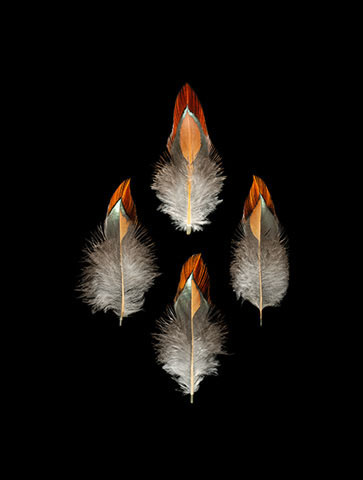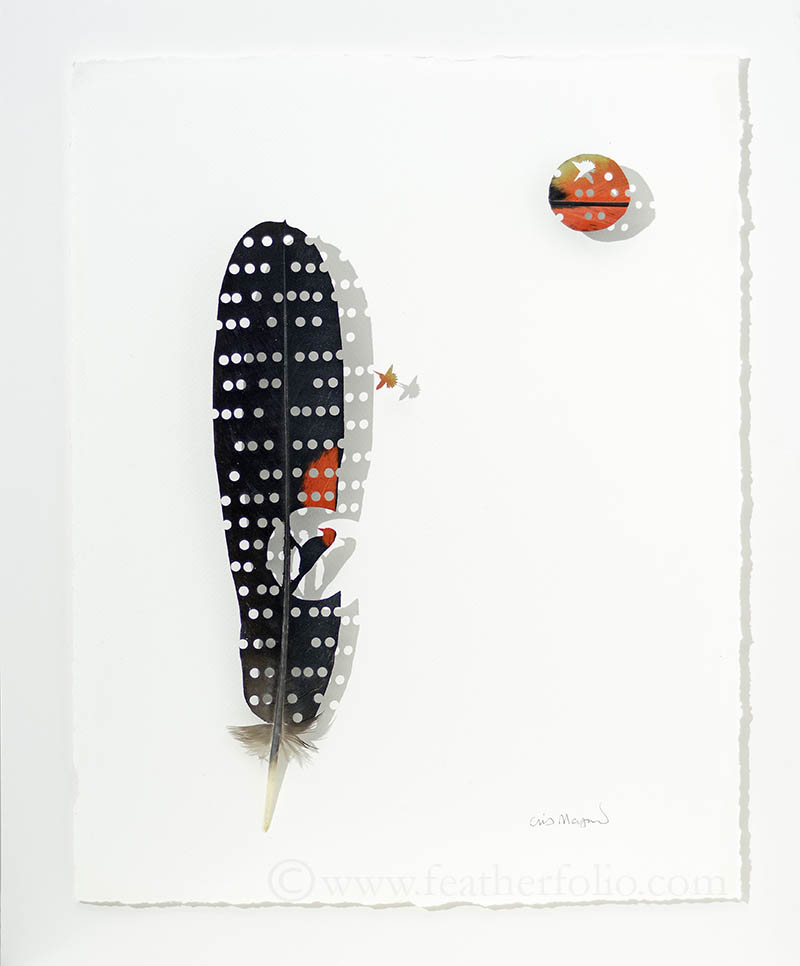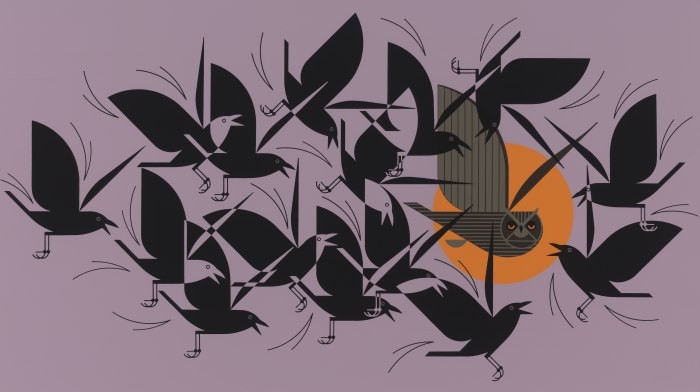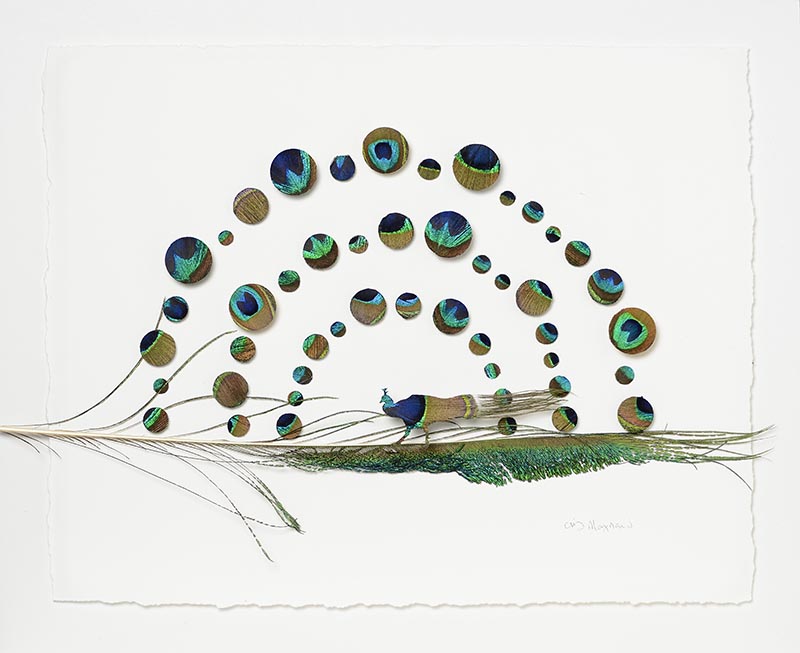Happy Valentine’s Day! Who knows if heart symbol-shapes mean the same thing to birds as they do to us. Probably not. Even though birds’ hearts are similar in shape and function to ours, they are relatively bigger. They pump more blood and usually beat faster—a lot faster, 1250 beats per minute for an active hummingbird. But when a hummingbird rests at night, the heartbeat goes down to only 50 beats a minute! I wonder how much faster a hummingbird heart beats when it wakes up, and sees its mate, its valentine.
Look what I found hiding in this feather /
This short video shows some of my process of cutting a turkey tail feather to bring out a little bird.
Everyone knows penguins as land waddlers but what fascinates me most is how well they swim. On a trip to the zoo, I watched and took pictures through an underwater viewing window. I envisioned these birds chasing schools of baitfish, even though the zoo keeper was feeding them dead herring or anchovies.
Later, I examined a stuffed Adelle penguin. Like the turkey, its tail feathers are the bird’s longest at five inches. The penguin uses these thick-shafted feathers not for display or flight but to make a three-legged stool: two feet and the tail.
An industrial chicken feather problem /
Rooster feathers.
From 50 billion chickens killed each year, industrial farmers around the world throw away almost all of their feathers: 8 billion pounds into landfills. The chicken farming business is so competitive that farmers make only a few cents on each bird. farmers would rather sell the feathers than throw them away. There is hope: universities and private research labs are busy finding ways to transform feather proteins into usable products; some are finding their way into the market, but most are in development to make them economically vialble. Here is a list of what I found trolling the WEB for a few minutes:
fertilizer ● animal feed ● extracts for liquid and solid fuel ● hydrogen fuel storage ● insulation ● absorbent materials for diapers and environmental contaminants such as radioactive strontium and cesium ● ingredients in paints ● filters ● mats for erosion control ● paper ● stuffing for furniture and mattresses ● moldable thermoplastics for soles of shoes, cups and plates, furniture, roofing, and for auto parts such as dashboards ● ingredients in cosmetics ● clothing ● boat construction (mixed with fiberglass ● and circuit boards.
Manufactures will soon take advantage of the special forms of protein found in feathers by grinding, mixing, heating, and formulating them with other chemicals to make feathers a bigger part of your life in the near future. Perhaps when writing a future blog article, I will use a keyboard made out of feather plastic, use a computer with circuitry made in part from feathers, and sit on a chair made of feathers, stuffed with ground and re-purposed feathers.
Population problems and chickens /
We humans, being quite inventive creatures, have successfully increased our population to over 7 billion. A lot of our inventions and population increase depend on fossil fuels. Where would we be without use of gas and oil to make fertilizers, to transport raw and finished materials, and to manufacture about everything?
If a certain measure of success is how many there are of an animal, chickens have got us beat. At any one time, 19 billion chickens live in the world according to the U.N. Food and Agriculture Organization. In a sense, they are using us. Like we are dependent on oil, they are dependent on us for their population success.
Where would chickens be without us? Probably where they started: a few relatively small populations of the four species of junglefowl, all in Asia. They look a lot like chickens. The feathers shown here are from a male green junglefowl who sports a beautiful pink, turquoise, and yellow comb on his head.
Next: what to do with all the chicken feathers?
Sources: 1. Howman, Pheasants of the World, 1993 and UN Food and Agriculture Organization http://faostat3.fao.org/browse/Q/QA/E
Mistake /
Quails-in-process mistake.
It’s funny, but when cutting detailed bird shapes out of feathers, I make very few cutting blunders.
When something has my full attention, mistakes become unlikely. When I make one, it is either a result of inattention to detail, skipping a step in the process, or because I am exploring the “cutting” edge of learning.
I cut the wrong side of one of these feathers when I skipped the step of checking my preliminary sketch to see where to make each cut. An artist, using oils or acrylics, can just paint over mistakes; or even paint over an entire piece. With a feather, an error means starting over. I am looking for a similar feather to replace this one that I ruined.
Blunders like this put me in mind of the process of evolution. A fault in a creature’s body usually makes life harder. The creature dies or doesn’t reproduce more of its kind because the mistake gets in the way. However, once in a great while, one of these errors makes life easier, more effective, better. I haven’t experienced a cutting-feathers-mistake contributing to better art…yet; though every once in a while, I seem to try.
These are guinea hen wing feathers. The piece, once I find a replacement feather, will be 30 by 20 inches, picturing California quails flying up into the circle of feathers.
The Feather Religion /
“The power of the wind was in the feather which he made you hold in your hand.”
Klickitat native Jake Hunt started this religion between 1898 and 1904. This was a during a generation of northwest USA natives who were experiencing huge changes in their cultures as European descendants restricted their ways of life and access to resources. It was related to the Washani (which also uses eagle feathers) and later, to the Shaker Native American religion.
An eagle feather was held in each hand and a person would spin. Songs were sung, drums played, and feathers waved to keep time. The feathers were used to brush sickness off the body and worn in the hair in prescribed ways as reminders of the powers of feathers, or at least by association, eagles.
“It seemed as though I were traveling as I had never traveled before because in my hand I held the feather…and it was leading me on.”
Quotes collected from Alice DuBois, The Feather Cult of the Middle Columbia, 1938, General Series in Anthropology, George Banta Publishing Co.
Book has arrived! Feathers Form and Function /
My new and first book is here: Feathers Form and Function. I am excited to be able to offer a profusion of my art and my thoughts about feathers all in one place. You will find quality in the design, the printing, and the materials used; and the way the printed colors accurately reflect the art. I undertook writing this book a year ago by gathering my previously published short articles, including some from this blog, researching, and mostly, regular writing appointments with my computer and notebook. The easy part was supplying the designers with art which I did up until the last minute so my latest works could be included in the book.
This website's book page describes the contents in more detail and provides an easy place to get a signed copy.
Nuthatches /
Mixed Flock.
On the side of a mountain under a ponderosa pine, a warm October sun lulled me into a sleepy happy place. Plop! Something small and hard fell on my face interrupting my dreams. Opening one eye, I spied a white breasted nuthatch working the tree over, looking for bugs by prying up loose bark, which rained down around me.
Lying there, occasionally dodging falling bark, I watched a flock of them for an hour. What struck me (besides the bark) was the agility and intensity of these little birds. They looked in every nook and crevice, upside down under branches, sideways, and on the trunk.
At 17 by 14 inches, this piece is made from two turkey feathers.
To Live /
I dream of taking a trip back through the eons that birds have been on the earth to see all the different shapes and forms and colors of the feathers that have come and gone. Some birds probably just slowly changed over generations to something better adapted to their surroundings while other species just perished. It would be a journey to see the continuation of the dance of life on earth. How do humans fit into the world today—from the perspective of feathers? The male peacock’s display feathers evolved to be so long and ornate that they place the bird at the edge of the ability to survive. The peacock’s tail limits its movements so much that a little more tail would keep it from escaping predators. We are impressively clever, active, and striving creatures. It seems like we keep getting more so. Our inherent ability to invent and build appears to place us at the edge of our ability to continue to thrive and maybe survive. What if through our inventiveness, as we grow in numbers, change our surroundings to suit our immediate needs, and reduce the ability of the earth to support us, we are evolving beyond our capacity to inhabit the earth?
Stickiness /
Try taking two flight feathers from the same side of a bird’s wing and put the front, leading edge parallel and over the trailing next feather, like it was on a bird. The pull them gently and you can feel the feathers grab. If you put the leading edge of a feather underneath trailing edge of its neighboring feather instead of on top, there will be no grabbing; they will just glide smoothly over each other.
These feathers stick together in at least three ways to help make the wing smooth and aerodynamic:
- The leading edges of the feathers let a small amount of air through as the bird flies, a little more air than comes through the trailing edges. This evens the pressures caused by moving air which would otherwise tend to pull feathers away from the smooth airfoil a wing is supposed to make for a bird to fly.
- The leading edge of each feather curves slightly down and the trailing edge faces slightly up. So when two flight feathers on a wing overlap, the leading edge grabs trailing edge of the next flight feather.
- The almost microscopic barbules on the leading and trailing edges of each flight feather sort of splay out which help to grab onto the next feather, further creating more of a seal so the feathers stick together firmly in the wind.
Reference: Muller, V. and Patone (1998) Air Transmissivity of Feathers. Journal of Experimental Biology 201, 2591-2599
Killing Birds for Ebay /
Someone is killing wild Great Argus Pheasants in SE Asia and selling their feathers on Ebay. It is making me sad as these pheasants are one of my favorite birds. Partly why I use feathers in my art is because they are freely given by birds. These pheasants shed their feathers every year where they are kept in zoos and private aviaries. I want people to appreciating life through my photography and art, not kill it; and especially not buy feathers from birds that were killed for their feathers.
Can taking pictures of beautiful birds and feathers or making art from them urge someone to buy feathers from birds that were killed for their feathers? I hope not. But it is a thought that bothers me and several wildlife photographers I have spoken to. I did report this auction to Ebay and federal authorities.
Designing with Feathers Presents a Problem /
Feather shapes and sizes are quite limited. How does one arrange a typically large, long and skinny feather into a wider picture? Many of my pieces center on a single cut feather. In order to create a pleasing, unified, creative design that tells a story or conveys a feeling, there has to be more to the design than just the single feather. That is, unless the final picture is long and skinny. I prefer not to do that. I have placed feathers drifting off a preening bird image to fill the space. Sometimes I add small feathers to balance a picture as with a cut-feather silhouette of a bird singing with feathers coming out of its mouth. Using two or more large cut feathers has sometimes solved the dilemma.
Working feathers into unified designs is all part of a vexing but rewarding process of creation. Sometimes I wish wild birds would grow big wide, wide feathers to make this process easier. But that wouldn't help the birds very much would it?
The Feather and the Ant /
I am not the only one who appreciates a fallen, shed feather that I find on the ground. I came across this ant who came across this feather on a windy day. I am not sure why the ant appreciates the feather, but it does and is able to something about it, a testament to its strength and the feather’s lightness. Good luck, Ms Ant.
A Perfect Passion /
I made a humbling discovery that I am not the only one who has a passion for showing off feathers in unsuccessful attempts to enhance already perfect natural beauty.
Hummersucker /
Hummingsucker.
The red-breasted sapsucker drills neat rows of holes in various trees and feeds on the sap. It maintains the holes so the sap keeps flowing. Luckily for the Anna’s hummingbird, this sap (which is a tree nectar) is available to slurp when flowers are out of season in the Northwestern USA winter. Both of these sap-loving birds show striking splashes of red feathers. The hummingbird displays metallic red on its throat, and the sapsucker presents a bright red head and breast.
Jay Sunbather /
Shaking sparkling drops shimmer in the sun. A jay needs its bath just like you and me. A good bath and shaking will loosen dust, dislodge mites, shake off dander, remove loose feathers, de-oil, and clean messes. In a pinch, a dust bath will do. But bathing is just a start. When done with the bath, the jay flies to a safe perch and preens for an hour, finishing for the moment, the never-ending task of keeping its feathers in impeccable shape.
Owl for One and One for Owl /
Charlie Harper, Owltercation
I have rediscovered the artist, Charlie Harper. In his art, he reduced the complexity of animal shapes into their essences in geometrical forms. He also had a fondness for and understanding of the natural world which he captured, often with a sense of humor. Charlie Harper’s piece,Owltercation (in addition to watching three crows chase an owl out of the tall fir tree near where I live) inspired me to design this feather shadowbox I call, Owl for One and One for Owl.
Peacock Feathers Illegal /
Peacock 6
Like the eagle in the United States, the blue peacock is the national bird of India. It follows then, that like the USA, India also made killing peacocks illegal. In the USA, you cannot have feathers from their national bird. But in India, you can have peacock feathers but only if they are naturally shed. To find out if a feather is naturally shed or if it was plucked from the skin of a bird, authorities simple place the shaft under a fairly low magnification to examine the base of the shaft. They also use their technology to perform a simple chemical test.
A very large down feather /
The biggest, fluffiest down feathers that I know of grow under the tail of a male peacock. They stick out from the back of the male bird when it is displaying. Since in India where they are from, peacocks don’t have a lot of need to protect against cold, perhaps they use them for display? They are rather prominent, but only from the back-side. So why are they on the rear-end if the business side of the peacock display is the front? Unlike this down feather built around a long central shaft, the lightest of down has hardly any central shaft at all, just long fluffy barbs coming off a shaft so short that you can barely feel it when you roll the down between your fingers. For their size, these feathers are so light, they come close to defying gravity. Why then are they called “down” when perhaps a more fitting name would be “up”?
A bug in the works /
Shelter 2
To make the background for this piece, I took apart, flattened, and pasted a big paper wasp nest. It was just finished and framed when I noticed a bug crawling around inside. Apparently, the paper had hid a little beetle living in a fold. The beetle chose to come out an hour after I had sealed up the entire piece. So now I have to take it apart, remove the beetle, and freeze the whole thing—which is what I should have done to the wasp nest in the first place like I do to all my feathers.
Feathers have bugs too, which are adapted for living and chewing on them. They have mites. And certain beetles can eat feathers. Fortunately, a few 48-hour, zero degree Fahrenheit chillings kills these tiny creatures, so I have never had a problem as long as the feathers are stored in a sealed place. I have two shadowboxes full of arranged and still perfect feathers that has been around for 25 years.















